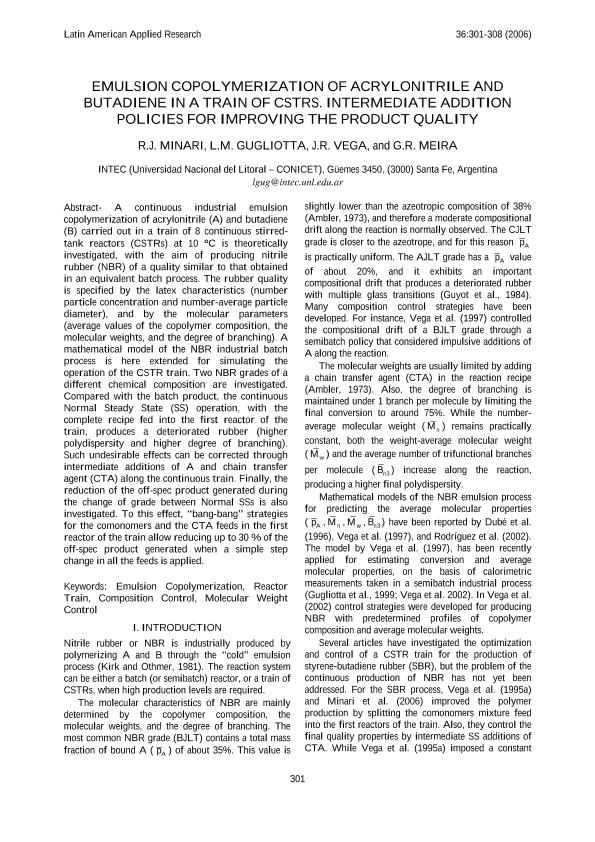Artículo
Emulsion copolymerization of acrylonitrile and butadiene in a train of CSTRS. Intermediate addition policies for improving the product quality
Fecha de publicación:
12/2006
Editorial:
Plapiqui
Revista:
Latin American Applied Research
ISSN:
0327-0793
e-ISSN:
1851-8796
Idioma:
Inglés
Tipo de recurso:
Artículo publicado
Clasificación temática:
Resumen
A continuous industrial emulsion copolymerization of acrylonitrile (A) and butadiene (B) carried out in a train of 8 continuous stirredtank reactors (CSTRs) at 10 °C is theoretically investigated, with the aim of producing nitrile rubber (NBR) of a quality similar to that obtained in an equivalent batch process. The rubber quality is specified by the latex characteristics (number particle concentration and number-average particle diameter), and by the molecular parameters (average values of the copolymer composition, the molecular weights, and the degree of branching). A mathematical model of the NBR industrial batch process is here extended for simulating the operation of the CSTR train. Two NBR grades of a different chemical composition are investigated. Compared with the batch product, the continuous Normal Steady State (SS) operation, with the complete recipe fed into the first reactor of the train, produces a deteriorated rubber (higher polydispersity and higher degree of branching). Such undesirable effects can be corrected through intermediate additions of A and chain transfer agent (CTA) along the continuous train. Finally, the reduction of the off-spec product generated during the change of grade between Normal SSs is also investigated. To this effect, “bang-bang” strategies for the comonomers and the CTA feeds in the first reactor of the train allow reducing up to 30 % of the off-spec product generated when a simple step change in all the feeds is applied.
Archivos asociados
Licencia
Identificadores
Colecciones
Articulos(INTEC)
Articulos de INST.DE DES.TECNOL.PARA LA IND.QUIMICA (I)
Articulos de INST.DE DES.TECNOL.PARA LA IND.QUIMICA (I)
Citación
Minari, Roque Javier; Gugliotta, Luis Marcelino; Vega, Jorge Ruben; Meira, Gregorio Raul; Emulsion copolymerization of acrylonitrile and butadiene in a train of CSTRS. Intermediate addition policies for improving the product quality; Plapiqui; Latin American Applied Research; 36; 4; 12-2006; 301-308
Compartir




